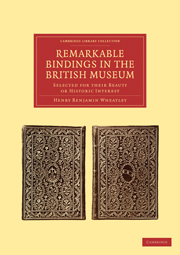Book contents
- Frontmatter
- PREFACE
- Contents
- INTRODUCTION
- I DEPARTMENT OF MANUSCRIPTS
- II DEPARTMENT OF MANUSCRIPTS
- III DEPARTMENTS OF MANUSCRIPTS AND PRINTED BOOKS
- IV DEPARTMENT OF PRINTED BOOKS
- V DEPARTMENT OF PRINTED BOOKS
- VI DEPARTMENT OF PRINTED BOOKS
- VII DEPARTMENT OF PRINTED BOOKS
- TABLE
- BOOKBINDING CONSIDERED AS A FINE ART, MECHANICAL ART, AND MANUFACTURE
- PREFACE
- CONTENTS
- HISTORY OF BOOKBINDING
- BINDING AS A FINE ART
- BINDING AS A MECHANICAL ART
- BINDING AS A MANUFACTURE
- PRACTICAL POINTS CONNECTED WITH BINDING
- APPENDIX
- DISCUSSION
- CATALOGUE OF SPECIMENS OF BINDING LENT FOR EXHIBITION
- LIST OF ENGRAVINGS
- Plate section
- Plate section
- Plate section
BINDING AS A FINE ART
Published online by Cambridge University Press: 05 March 2012
- Frontmatter
- PREFACE
- Contents
- INTRODUCTION
- I DEPARTMENT OF MANUSCRIPTS
- II DEPARTMENT OF MANUSCRIPTS
- III DEPARTMENTS OF MANUSCRIPTS AND PRINTED BOOKS
- IV DEPARTMENT OF PRINTED BOOKS
- V DEPARTMENT OF PRINTED BOOKS
- VI DEPARTMENT OF PRINTED BOOKS
- VII DEPARTMENT OF PRINTED BOOKS
- TABLE
- BOOKBINDING CONSIDERED AS A FINE ART, MECHANICAL ART, AND MANUFACTURE
- PREFACE
- CONTENTS
- HISTORY OF BOOKBINDING
- BINDING AS A FINE ART
- BINDING AS A MECHANICAL ART
- BINDING AS A MANUFACTURE
- PRACTICAL POINTS CONNECTED WITH BINDING
- APPENDIX
- DISCUSSION
- CATALOGUE OF SPECIMENS OF BINDING LENT FOR EXHIBITION
- LIST OF ENGRAVINGS
- Plate section
- Plate section
- Plate section
Summary
I now pass on to consider Bookbinding as a Fine Art, and here I feel that I am treading upon dangerous ground and walking without a guide. All agree that binding should take rank among the decorative arts, but I do not find that any principles have been evolved for the guidance of the binder, or that any definite indication of the points of its connection with or divergence from other arts has been satisfactorily set forth.
De Quincey, in alluding to the choice of the trade of bookbinding by the Ferrars, writes:— “Why this was a good trade to choose, I will explain in a brief digression. It is a reason which applies only to three other trades, viz., to coining, to printing books, and to making gold or silver plate. And the reason is this–all the four arts stand on an isthmus, connecting them, on one side, with the vast continent of merely mechanical arts; on the other side, with the far smaller continent of fine arts.” This is true in a double sense, for in one point of view, every good binder who tries to work out an idea is an artist, whether the result is plain or ornamental; and, in another, the finished side of some richly tooled book is as much a work of art as any picture or drawing.
- Type
- Chapter
- Information
- Remarkable Bindings in the British MuseumSelected for their Beauty or Historic Interest, pp. 159 - 161Publisher: Cambridge University PressPrint publication year: 2010First published in: 1889



